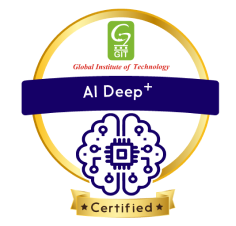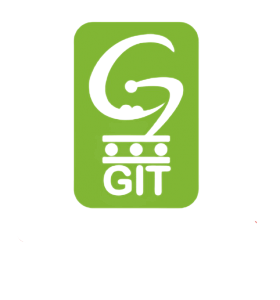
Machine And Deep Learning)
Are you ready to embark on a transformative journey into the world of Artificial Intelligence (AI)?
NEXT STARTS
Enrollment is ongoing. Join today—spots are filling fast!
PROGRAM DURATION
80 Hours
LEARNING FORMAT
Online Bootcamp
Course Description
The Global Institute of Technology ‘Machine and Deep Learning ‘ is a Foundational Certification program designed to prepare learners for mid-level employment opportunities in the field of Machine and Deep Learning in Artificial Intelligence. Throughout this program, students will Learn to set up your development environment with Python, Jupyter, and essential libraries, gaining hands-on experience in data manipulation. Explore both supervised and unsupervised learning, delving into classification algorithms and model evaluation metrics.
Master dimensionality reduction techniques to simplify complex datasets and gain insights. Grasp the fundamentals of deep learning, including neural networks and backpropagation, and apply these skills to practical exercises.
By the end of this course, you’ll have a solid foundation in machine and deep learning, equipping you to tackle real-world challenges and harness the potential of these transformative technologies.
Course Objectives
Upon completing this comprehensive course in Machine and Deep Learning, participants will:
- Get an Introduction to Machine Learning
- Setting up the Development Environment (Python, Jupyter, Libraries)
- Understand Supervised and Unsupervised Learning
- Delve into classification algorithms
- Explore Dimensionality Reduction Techniques
- Grasp Deep Learning Fundamentals and Training Nural Networks
- Introduce to Deep Learning Advanced Topics
- Work on Transfer Learning and Pre-trained Models
Upon completing this course, you will have gained a solid foundation in machine learning, deep learning, and practical data analysis skills, enabling you to apply these techniques to real-world problems and projects.

Prerequisites
Basic understanding of Artificial Intelligence and Data Analysis is a plus
Course Duration
80 Hours (40 Hours Instructor-led live training and 40 Hours Instructor Guided)
Prerequisites
Basic understanding of Artificial Intelligence and Data Analysis is a plus
Course Duration
80 Hours (40 Hours Instructor-led live training and 40 Hours Instructor Guided)
Course Contents
1. Introduction to Machine Learning (4 hours)
- Welcome and course overview.
- Introduction to machine learning: What is ML, its applications, and why it matters.
- Types of machine learning: Supervised, Unsupervised, and Reinforcement Learning.
- Machine learning workflow: Data collection, preprocessing, model training, evaluation, and deployment.
2. Setting up the development environment (Python, Jupyter, libraries) (4 hours)
- Hands-on exercise: Writing your first Python script to load and visualize data.
- Introduction to NumPy and Pandas for data manipulation.
3. Supervised Learning (4 hours)
- Supervised learning overview.
- Linear regression: Theory and implementation.
- Hands-on exercise: Implementing linear regression.
4. Classification algorithms (4 hours)
- Logistic regression, decision trees, random forests, xgboost, and support vector
machine - Hands-on exercise: Implementing a classification model.
- Model evaluation metrics: Accuracy, precision, recall, F1-score, ROC curve, and AUC.
5. Unsupervised Learning (4 hours)
- Unsupervised learning overview.
- Clustering algorithms: K-Means, hierarchical clustering, LDA and DBSCAN.
- Anomaly detection: isolation forest
- Exploratory data analysis
- Hands-on exercise: Clustering data.
6. Dimensionality reduction techniques (4 hours)
- PCA and t-SNE
- Encoders and Decoders
- Hands-on exercise: Applying dimensionality reduction to data.
7. Deep Learning Fundamentals (4 hours)
- Introduction to neural networks: Neurons, layers, and architectures.
- Building a simple feedforward neural network from scratch.
- Activation functions: Sigmoid, ReLU, and more.
8. Training neural networks (4 hours)
- Backpropagation and gradient descent.
- Hands-on exercise: Training a feedforward neural network.
9. Deep Learning Advanced Topics (4 hours)
- Convolutional Neural Networks (CNNs) for image recognition.
- Recurrent Neural Networks (RNNs) for sequential data.
- Introduction to deep learning frameworks (TensorFlow or PyTorch).
- Hands-on exercise: Implementing a CNN or RNN.
10. Transfer learning and pre-trained models (4 hours)
- Model deployment and serving.
- AI Governance
- MLOps
- Course wrap-up, Q&A, and next steps.
Instruction Details:
Throughout the course, we will intersperse practical exercises, coding assignments, and projects to reinforce concepts and skills learned during the lectures. Encourage students to work on real-world datasets and problems. Additionally, provide resources such as textbooks, online tutorials and datasets for further self-study.
Assessment methods could include quizzes, assignments, a final project where students apply their knowledge to a real problem, and possibly a written exam to evaluate theoretical understanding.
Students gain practical experience in machine and deep learning.
Your AI journey begins here. Join us at Git Services, and let’s explore the limitless possibilities of Artificial Intelligence together.
Resources
- “Pattern Recognition and Machine Learning” by Christopher M. Bishop
- “Deep Learning” by Ian Goodfellow, Yoshua Bengio, and Aaron Courville
- “Hands-On Machine Learning with Scikit-Learn, Keras, and TensorFlow” by Aurélien Géron
- “Python Machine Learning” by Sebastian Raschka and Vahid Mirjalili
- “Deep Learning for Computer Vision” by Rajalingappaa Shanmugamani
- Python Deep Learning: Exploring deep learning techniques and neural network architectures with PyTorch, Keras, and TensorFlow, 2nd Edition 2nd Edition, Kindle Edition by Ivan Vasilev, Daniel Slater, Gianmario Spacagna, Peter Roelants, and Valentino Zocca
- “Introduction to Artificial Intelligence” by Wolfgang Ertel
- “Machine Learning Yearning” by Andrew Ng
- “Practical Convolutional Neural Networks” by Mohit Sewak, Md. Rezaul Karim, and Pradeep Pujari
- “Natural Language Processing in Action” by Lane, Howard, and Hapke
